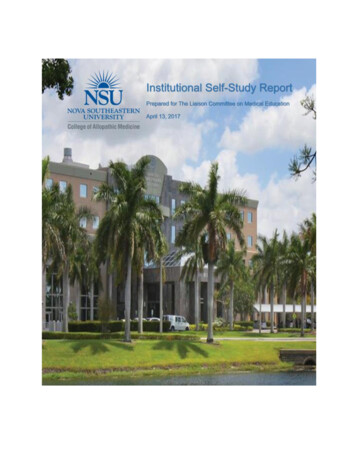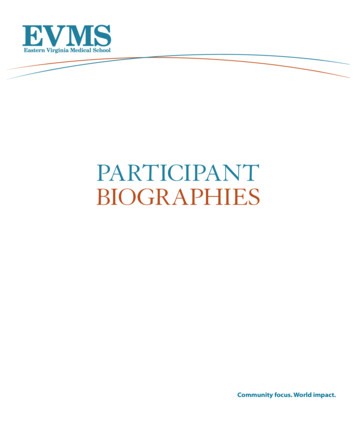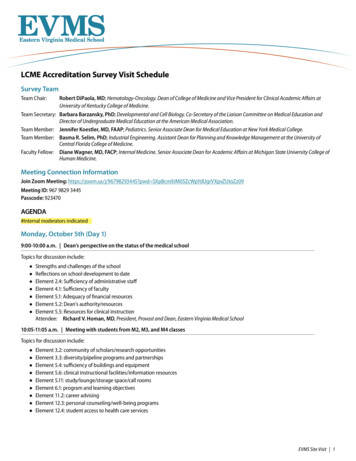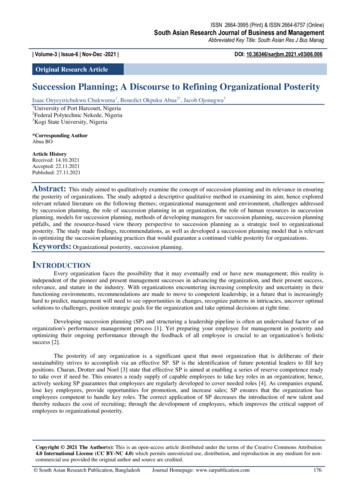
Transcription
INSTITUTIONAL PLANNING SELF STUDY (LCME)INTRODUCTION TO SUMMARY REPORT/HISTORY OF NSUNova Southeastern University (NSU) is located on a 314-acre campus in the Fort Lauderdale/Davie areain Broward County, Florida. The university was chartered in 1964 as an independent, private, not-forprofit university. NSU has a current enrollment of 23,000 students. Additionally, there are regionalcampuses in Miami-Kendall, Palm Beach, Fort Myers, Tampa, Orlando, Miramar, and Jacksonville,Florida, and a regional campus in San Juan, Puerto Rico. As a life sciences-focused university, NSU hasaccumulated an impressive portfolio in biomedical research, health education, and applied health services.NSU has a distributed model of higher education, and offers a comprehensive portfolio of undergraduate,graduate and professional degrees through 18 Colleges, schools, and centers, including Arts, Humanities,and Social Sciences; Psychology; Business and Entrepreneurship; Human Development; Education;Engineering and Computing; Honor’s College; Law; Natural Sciences and Oceanography; and aUniversity School (Pre-K-12 prep school). There are eight health professions Colleges at NSU, organizedinto the HPD of the university: Allopathic Medicine (CAM or the College), Dental Medicine, Health CareSciences, Medical Sciences, Nursing, Optometry, Osteopathic Medicine, and Pharmacy.NSU is accredited by the Southern Association of Colleges and Schools Commission on Colleges(SACSCOC) and has numerous additional professional accreditations. Significantly, NSU has a CarnegieFoundation Community Engagement Classification and meets the US Department of Education's criteriaas an Hispanic-serving Institution.THE COLLEGE OF ALLOPATHIC MEDICINEIn 2010, the NSU president, senior members of the faculty and community advocates nurtured a vision toestablish a four-year allopathic medical school that would complement NSU’s comprehensive educationalportfolio in health education and health service.Timeline and Milestones February 2012: A university needs-assessment concludes that “a new MD degree-awarding medicalschool would most appropriately fit into NSU’s vision and mission and will add educationalopportunities for students and improve health care through the education of highly skilled, culturallycompetent physicians.” September 2013: NSU and the Hospital Corporation of America (HCA), East Florida Divisionannounce a partnership. HCA agrees to construct an acute-care hospital to be a teaching and researchfacility integrated with NSU’s clinics, which would also serve as a venue for MD students to receiveclinical training. This hospital will be located on NSU’s campus in Ft. Lauderdale/Davie. April 2015: The NSU Board of Trustees authorizes planning for a new four-year allopathic College atthe main campus. July 2015: The NSU president notifies the SACSCOC and the National Association of IndependentColleges and Universities (NAICU) of NSU’s plans to create an allopathic medical school in BrowardCounty in south Florida. February 2016: Following a national search, Johannes W. Vieweg, MD, FACS, is appointed as theFounding Dean to the NSU CAM.2
March 2016: An administrative judge approves HCA’s “certificate of need” application forconstruction of a 200-bed acute care hospital on the NSU campus. The new hospital will relocatebeds from Plantation General Hospital and will serve the surrounding community, functioning as ateaching and research hospital integrated with NSU’s research centers and clinical trial programs. Dr.Vieweg begins recruiting his executive staff. July 2016: A Curriculum Committee (CC) is constituted with educational experts on campus. August 2016: Dean Vieweg contacts the LCME Secretariat and discusses the College’s planning,governance and resources with the goal of achieving preliminary accreditation in 2018. September 2016: The NSU Center for Collaborative Research (CCR) opens on the NSU maincampus. This 215,000-square-foot building will house the College’s research faculty involved instudies on cardiovascular disease, anti-cancer therapies, chronic fatigue syndrome, autism, andregenerative medicine, among other areas of concentration. October 2016: The NSU president and Dean Vieweg commence planning for constructing a 200,000 square foot academic medical education building and providing medical simulation resources. February 2017: The CAM receives “applicant” status from LCME and requests a consultation visitfrom the Secretariat. An affiliation agreement is signed with HCA to provide core clerkships andelective rotations for students. March 2017: The AAMC Secretariat meets with leadership, faculty and administrators to provide aconsultative review of the planning efforts at the CAM. April 2017: The College submits required documentation to the LCME for review at the Junemeeting and awaits notice that a site visit by a survey team of peer educators will be granted in Fall2017, with the hope of receiving permission to enroll the charter class of 50 matriculating students inAugust 2018.According to the US Census Bureau, Florida is the nation’s third-most populous state with an estimated21 million residents. Particularly, the South Florida metropolitan area, including Broward, Miami-Dade,and Palm Beach counties, has become the eighth-most populated region in the US, exceeding six million,with a growth rate of approximately 800 new residents per day. Despite recent advances in improvinghealth delivery, in establishing new medical schools, and emergence as a global medical tourismdestination, Florida’s healthcare system is facing major challenges as the demand for physicians isoutpacing the current supply. Therefore, extending both undergraduate and graduate medical educationthrough a well-coordinated approach with a strong clinical partner is necessary to meet the medical workforce needs of the state.INSTITUTIONAL PLANNINGInstitutional planning efforts, to date, are highly focused on welcoming a charter class to the College inAugust, 2018. All activities are on target, including the development and adoption of the College’smission and vision statements and design for most of the pre-clerkship curriculum along with plans forfaculty recruitment, facilities renovation and faculty governance. An institutional self-study steeringcommittee, with participation by members of the university, faculty, staff and the community, wascharged in October 2016. It was chaired by Dr. Paula S. Wales, the executive associate dean for academicand student affairs (EADASA). Twelve (12) self-study task force subcommittees were formed followingthe accreditation standards. Some consolidation of subcommittees occurred as the self-study processprogressed. The roster of participants is appended.3
Since May, 2016, when the founding dean’s team of administrators, personally recruited and selected bythe dean, began arriving at the College offices in the Terry Building on the NSU campus, the daily workof planning has continued at an efficient pace due to the dean’s early involvement and guidance. Keypositions on the dean’s staff were filled first, including hires for curriculum management andaccreditation. Accordingly, the earliest planning activities included the crafting of institutional missionstatements based on the dean’s vision and creating the framework for the innovative, integrated problembased learning curriculum.The College’s original business plan, formulated in February 2015, presented a nimble organizationalmodel that has been expanded and modified to support the dean’s workplan and provide pro formafinancials for the first decade of operations. The first measurable outcomes from this plan were toenvision and build the broad administrative and creative support necessary for the tasks of curriculumdesign and achieving accreditation. This has been successfully accomplished. Planning for the shared andcore faculty model and the integration of faculty contributions to research and scholarship were also at theheart of these complementary goals. Not only will there be solid, scientific and pedagogical research withprovisions for innovative service, cutting-edge clinical practice and the provision of experienced contentexpertise, there is also the culture of collaborative effort, together with a developing appreciation of theunique requirements for the curriculum and the goals of accreditation. The efficiency of the team’sactivities has produced thoughtful, well-considered results directed at achieving preliminary accreditationin time to welcome a charter class in August, 2018.Faculty content experts from the College of Medical Sciences (CMS) have designed the pre-clerkshipbasic science curriculum, following a framework derived during their early task of formulatingcompetencies and learning objectives. The pre-clerkship clinical curriculum and threads have beendesigned by faculty from other NSU Colleges and the community. The pre-clerkship curriculum will beuploaded to the eMedley curriculum management system by staff in the dean’s office. The simultaneouscompletion of the accreditation DCI has insured that consideration of LCME standards are embedded inall planning activities. Under the guidance of the dean’s team, which includes senior faculty leaders, anassistant dean for quality, and an accreditation expert, all with full-time effort, the required accreditationdocuments for submission have been thoroughly vetted. Pre-determined accreditation milestones,established through the planning activities, have been achieved for an April submission of all documents.Continuous quality improvement is embedded in the charge to the planning team to ensure the College’sprogress toward strategic planning goals. Resources are sufficient for designing, documenting, compiling,verifying and validating the high-volume work. An invited visit from the LCME Secretariat also assistedwith internal assessments for readiness.The founding dean’s vision provides benchmarks for strategic planning to guide the next phase ofpreparation, to be completed in December, 2017. The vision will be solidified through the strategicplanning and quality improvement documents. A committee will be charged to derive these importantbenchmarks by which the dean, the university president, and the Board of Trustees will measureachievement. Measurable outcomes may include: a representative, working faculty governance structure;appropriate, expanded clinical affiliations; and additional community involvement to promote meaningfuloutreach and expand pipeline programs for student recruitment in groups under-represented in medicine(URiM). These goals reflect the local mission to be a transforming entity as the College’s footprintexpands outward.STANDARD 1: MISSION, PLANNING, ORGANIZATION, AND INTEGRITYThe institutional self-study subcommittee assigned to this topic reviewed the voluminous informationprovided on the planning efforts for accreditation Standards 1, 2 and 5. The group noted the documents4
are explicit regarding efforts to accomplish the College’s mission and achieve the desired outcomes in ameasureable way. The subcommittee commended the planning from the dean’s office and was confidentthe College will meet short-term goals for submission of accreditation documentation. Longer-termachievements are projected and will be part of the strategic planning phase to begin mid-year. Thesestrategic goals will be scheduled for the next few years, as the faculty, staff and leadership work towardfull accreditation of the educational program leading to the MD degree and continue to implementplanning activities. Quality and policy efforts will focus on establishing methods to monitor compliancewith accreditation elements and will be applied to all activities where indicated. The plans were endorsedby the subcommittee as appropriate and workable.The subcommittee reviewed the mechanisms for conflicts of interest at the levels of the Board ofTrustees, the College’s administration, and the College’s faculty to determine whether they areappropriate and concluded they present reasonable safeguards to prevent and/or identify breaches ormisconduct.The subcommittee noted the early and direct faculty involvement in decision-making related to themedical education program. They reviewed the joint appointments of CMS faculty and involvement ofother faculty, which promoted early participation in curriculum design by core teaching faculty. Active adhoc task forces of the CC also contributed to various faculty-led initiatives to improve the design phase.As well, the Admission Committee was under the early advisement of an experienced chair and usedfaculty-derived criteria for their determination of admissions requirements. Finally, the creation of facultybylaws was based on accreditation guidelines and they were written, reviewed and ratified by the faculty.The subcommittee reviewed and endorsed the committee structure at the College and determined there aresufficient opportunities for participation in governance outside and inside of the committees through theFaculty Council, the representative body which will be activated when a critical number of core teachingfaculty are appointed. The autonomy of the faculty of the College is mandated via LCME standards. Thesubcommittee recommended a review of the faculty bylaws by the Provost to assure alignment with thatoffice’s expectations.Communications on campus among constituent groups including faculty were deemed by thesubcommittee to be very robust. College policies and procedures will be readily accessible via theuniversity’s website and in a variety of other locations electronically, including a portal specifically forthe College. These methods of communication were judged by the subcommittee to be effective,particularly with the provision for access by any faculty member with logon credentials, at any time, andfrom a variety of electronic devices. The opportunities to comment on policies and procedures will beuniversally available.HCA East Florida Division is the College’s primary partner for clinical training of MD students andCAM has a signed affiliation agreement with the corporation. The self-study subcommittee was briefedon plans to add the West Palm Beach Veterans Affairs Medical Center when preliminary accreditation isachieved. Additional HCA hospitals will also increase the College’s capacity to offer a variety ofclerkship experiences. Where they may not provide the necessary patient mix or facilities, there are otherentities with which the dean has initiated discussion. His goals to build a consortium of academic,patient-centered facilities for CAM students are part of future strategic plans. The subcommittee reviewedthe AAMC recommendations for affiliation agreements with specific attention to the language regardingcontrol by the College’s faculty and validated the presence of this language in the signed contract withHCA. The subcommittee agreed these efforts are on track and lauded the dean for his leadership.As noted previously, College bylaws for the faculty have been developed, ratified, and were available forthe subcommittee to review. The subcommittee noted they present a blueprint for the standing committeestructure and permit expansion of faculty participation in governance. The subcommittee noted thebylaws will also come under periodic review by the faculty.5
The College is working collaboratively with the university to provide data for the SACSCOCaccreditation and the subcommittee noted that, while these efforts are on a parallel timeline as both theLCME and SACSCOC will be in receipt of a comprehensive data set regarding the College in April,2017, progress is on track.STANDARD 2: LEADERSHIP AND ADMINISTRATIONThe subcommittee concluded the authority is appropriate for the work of the faculty and theadministration and enables all personnel and groups to make progress in their task to create a College thatis ready to accept a charter class of medical students. The exercise of this authority has been autonomousat the College and has permitted the finances, faculty and facilities to be allocated efficiently. Thesubcommittee expressed admiration for the efficient progress made by the dean’s team in gettingunderway immediately upon their arrival to campus. The subcommittee also praised the work of theuniversity units that facilitated activities aimed at assuring the College’s programs are in readiness for anaccreditation review.Dean Vieweg is an accomplished leader, academician and clinician with a track record of success. Hisvision for the College encompasses an awareness of the rich local resources with a focus on possibilitiesin the global arena for the future direction of the College and the university. As such, his vision iscongruent with the university’s administrative leadership’s goals and visions. This shared viewpointpermits synergies and support for an impressive number of initiatives for which he is responsible. Ofprimary importance is the successful launch of the College, for which he has appropriate access touniversity and other officials. The subcommittee voiced confidence in the dean’s ability to carry out theseresponsibilities successfully.Currently there are sufficient experts and experienced staff in place to proceed with planning and programdevelopment; the subcommittee noted the impressive cadre of College administrators who are already inplace. Comprehensive plans for additional hires, scheduled to come on board over the next year, werealso noted. The first five hires to the dean’s team bring a combined 75 years of experience in academicmedicine and accreditation. Their expertise includes work with established and start-up medical schoolsover several decades. As the dean’s team continues to expand, the additional deans and senior staff willadd to the breadth of competencies on which the College will rely and the subcommittee was confidentthe judgement of the dean for recruiting the best personnel. Further, all hires that are central to theadministration will be in place in advance of the arrival of the charter class.Vacancies are being filled at an appropriate pace to support development of the program, using the sharedmodel for faculty with content experts for curriculum development. Competent and enthusiasticuniversity employees have joined the MD program and they bring the knowledge of the extant systemsfor efficient functionality on arrival. Their seamless integration into the administrative structure is atribute to Dean Vieweg’s abilities to build a team with commitment to the emerging College but withrespect for the existing level of excellence on offer with the university.6
STANDARD 3: ACADEMIC AND LEARNING ENVIRONMENTSAll NSU CAM students will have the opportunity to complete at least one required clinical experiencewhere they will interact with residents. The subcommittee noted the residency training programs in placeat the affiliated institutions, HCA East Florida Division, and reviewed plans for additional trainingprograms which indicate the charter class will have sufficient access, as required, to resident physicians in2020 when they begin the clinical clerkships.The subcommittee reviewed the College’s access to a richly resourced scholarly environment for facultyand students on the university campus with facilities in close proximity to classrooms. The resources,support, and encouragement for medical students to participate in research are evidenced through thecurriculum design, which builds in time for student-initiated or faculty-directed research activities andincludes a longitudinal curricular thread to reinforce the principles of basic and translational research. Thesubcommittee noted the ready availability of basic scientists in the Nova Southeastern University CCR,which will provide opportunities for students to work alongside funded investigators in several researchinstitutes including the NSU AutoNation Institute for Breast and Solid Tumor Cancer Research, the NSUCell Therapy Institute (CTI), the NSU Institute for Neuro-Immune Medicine, and the NSU RumbaughGoodwin Institute for Cancer Research. Off campus, collaborations with the Broward Regional HealthPlanning Council, the Broward County Division of Florida Department of Health, and other entities areunder development for student participation in research concerning population health, and clinicalresearch activities are under development. The subcommittee was assured that processes are on target toprovide for the required research experience for the charter class.The subcommittee reviewed the Diversity Committee’s suggested definitions and policies and judgedthem as reasonable to promote College and university goals for inclusion. Recruitment and retentionactivities for medical students are still undergoing planning and review. The DCI data indicates genderequity of the administrative leadership from inception; goals for other categories will be part of strategicplanning for the College. The subcommittee noted the successful pipeline models at the university whichcould be adapted to the College. A review of the plans for outreach to a national applicant pool will becoordinated with the Admissions Committee, which has begun meeting in anticipation of a charter classin 2018. The subcommittee deemed these plans appropriate and noted enthusiasm at the university forjoint degree offerings in the future.The subcommittee noted that the non-discrimination policy for the university has been adopted for theCollege with a few revisions. Attention to the importance of professional behaviors was discussed in thecontext of the allopathic medicine traditions of self-reflection, competency, and empathy. Assessmentsfor these traits are part of all aspects of the curriculum, and the subcommittee reviewed the expectationsfor self-awareness for which CAM students will be responsible.The subcommittee discussed the plans for evaluating the learning environment that include periodicevaluations by learners and teachers and that the clinical affiliates will share the responsibility for thisevaluation. The subcommittee noted these plans will need to be further developed before the clerkhipsbegin.The subcommittee reviewed draft documents for reporting and disposition of incidents of nonprofessional conduct at the College and noted they were complete at this time. The implications ofstatements of “could” and “should” for student reporting in the “mistreatment policy” were discussed inthe context of providing options and not being directive toward particular behaviors. Although there aremandatory reports for certain issues, the philosophy being promoted is to present students with methodsfor follow up with few barriers to reporting, to enable an environment of trust among students,administrators and faculty.7
STANDARD 4: FACULTY PREPARATION, PRODUCTIVITY, PARTICIPATION, ANDPOLICIESThe subcommittee reviewed the data on current and anticipated faculty numbers, discipline mix,qualifications and availability and agreed the medical education program will be well served by thiscohort. The subcommittee noted that, among founding faculty, the level of enthusiasm in support ofdevelopment of the MD program is very high. Due to the variety of opportunities for involvement, eachfaculty member is poised to serve the several missions of the College.The subcommittee thought that the planned number of core teaching faculty, supplemented by CMSfaculty with joint appointments and volunteer/affiliate faculty, appeared sufficient for teaching cohorts of50 students in each class. The workforce planning information that was available to the subcommittee wasmodified according to their suggestions for clarification prior to submission to the LCME.Current levels of scholarly productivity of the faculty are reasonable for a nascent program; thesubcommittee noted the emphasis already placed on faculty development for expanding research andscholarship. The College has stated research missions and goals as part of the defining principles forsuccess and the subcommittee is in support of these aims. Discussion ensued regarding the various typesof research that would be available and how these projects might be identified and supported. The groupalso discussed future scholarship goals, which would be rewarded through promotion and retentionpolicies for the faculty. Plans for educational and bench research were noted by the subcommittee asachievable, reasonable and on a timeline for measured growth. Dr. Jove noted that a 50M grantapplication to the NIH for effective research planning and faculty development was just submitted.The subcommittee reviewed NSU policies and procedures for faculty appointment, promotion, anddismissal and noted there is no tenure at the university. The long-term faculty on the subcommittee werefamiliar with the terms and conditions of the documents. They discussed that these documents are clear intheir presentation and have defined mechanisms for review of faculty, noting however that processreviews may be unevenly applied across colleges. CAM’s merit and promotion policy is underdevelopment.Subcommittee review of the mechanisms to ensure that all faculty will receive information related to theirresponsibilities, benefits, and remuneration revealed that, in practice, there are sometimes delays inrelation to expected NSU timelines. The timeline for review in the first year of a faculty member’s effortwas discussed in the context of what is required by the university and what each college may decide on itsown. Some reconciliation may be needed to align these policies, particularly for five-year contracts,which do not have an annual review component. The subcommittee expected that once the promotion andmerit policies and the compensation plan of the College have been codified, these matters will bereconciled.The subcommittee discussed the protocol under consideration by the College for assigning all teaching fora given academic year at least four months prior to the start of that academic year and felt that thisapproach will allow adequate time for coordinating the teaching schedules for part-time/shared faculty.Faculty progress toward promotion at the College was discussed by the subcommittee at length, includingthe need for concise benchmarks to avoid overly subjective review and assure clear progress and facultysuccess. The College’s plan for annual review of faculty by the department chair and coordination withother colleges for faculty with joint appointments were felt to be appropriate.Research faculty will have options to receive feedback from their supervising department head or otherpersons according to the rules for promotion and advancement. The subcommittee agreed thesedocuments seemed reasonable and would be tested appropriately over time to validate their efficacy.Additionally, the subcommittee noted the working definitions, useful rubrics, and easily navigated menus(all components of a “user-friendly” system) were needed for qualitative tracking of faculty progress8
toward promotion. The group suggested the possible utility of adopting an extant systems for example,Digital Measures, a proprietary program at the university.Professional development activities will be robust and supported by experts in this area. Thesubcommittee reviewed current activities for professional development, particularly in curriculumplanning, and was satisfied the framework and structure was sound for a new medical school program.The subcommittee was enthusiastic about the current and planned activities and endorsed the structure forfaculty development at CAM. Planned opportunities to enhance the teaching, assessment, evaluation, andresearch skills of the faculty will be rolled out after the preliminary accreditation documents have beensubmitted. The subcommittee noted there is good support for content experts, pedagogical novices, andall manner of “in between” faculty skill levels in the plans for professional development. Additionally,there has been discussion of provision for CME to enhance participation by physician faculty.The subcommittee noted the processes for governance and policymaking and determined the frameworkis in place to guide the dean and committees of the faculty (standing and ad hoc). Early evidence is insupport of the subcommittee’s conclusions.STANDARD 5: EDUCATIONAL RESOURCES AND INFRASTRUCTUREThe subcommittee did not access the financial projections for the College but viewed percentages forcurrent and anticipated financial support with the CFO, who also described the pro forma rationale in thecontext of LCME requirements for accreditation. The subcommittee noted, within these limits, that thevaried sources of financial support would seem to be adequate for the needs of the College during startup. The expenditure of university funds to create a quality medical education program have beenaccelerated recently to permit a ramp up of curriculum design, including a “command center” and anexpert on case-based learning to assist the EADASA with coordinating the design of the curriculum.While funding sources will need to be expanded in the first phase of the College’s planning, thesubcommittee recognized the potential for research and practice plan revenue to exceed the projections.University support has been critical to the progress made thus far, and the subcommittee noted that thiswill continue to be available to support the needs of the College.The subcommittee discussed the various resources which have been made available to the College frominception and concluded the rollout of assistance to launch the project has been impressive. Remodeledoffices in the HPD Terry Building have provided administrators and staff with an efficient, proximal“corridor” for collegial interactions and meetings. A refurbished conference room has been madeavailable for exclusive use by the College’s staff, an
Florida, and a regional campus in San Juan, Puerto Rico. As a life sciences-focused university, NSU has accumulated an impressive portfolio in biomedical research, health education, and applied health services. NSU has a distributed model of higher education, and offers a comprehensive portfolio of undergraduate,










